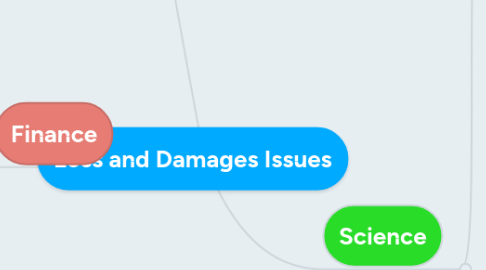
1. Negotiations
1.1. Political will to come to an agreement on loss and damages
1.1.1. Uncertainty surrounding the governing/ "decision-making" body in a loss and damage mechanism
1.1.2. Climate equity and justice
1.1.2.1. Polluter pays principle
1.1.2.2. Common but differentiated responsibilities
1.1.3. Classifying losses and damages
1.1.3.1. avoided damage
1.1.3.2. unavoided damage
1.1.3.3. unavoidable damage
1.1.4. Should L&D be a stand alone issue or should it be categorized under adaptation?
1.1.5. Channels of L&D finance
1.1.5.1. aid vs. liability
1.2. History and the growing importance of L&D in climate negotiations
1.2.1. 1991 - First mention of L&D through a proposal by Vanuatu
1.2.2. 2007 - IPCC's Fourth Assessment Report
1.2.3. 2007 - COP13 in Bali
1.2.4. 2010 - COP16 in Cancun
1.2.5. 2011 - Durban platform
1.2.6. 2012 - COP18 in Doha
1.2.7. 2013 - Warsaw International Mechanism
1.2.8. 2015 - COP21 in Paris
2. Finance
2.1. International Organisational Authority
2.1.1. Enforcement of Decisions
2.1.2. Method of Transfer
2.1.2.1. Frequency of payment
2.1.2.2. Currency of transfer
2.1.2.3. Amount
2.1.2.4. Conditionality of transfer
2.2. Private Sector Engagement
2.2.1. Technical Issues
2.2.1.1. New Mechanism for Slow Onset Events
2.2.1.2. Post-catastrophe Damage Assessment
2.2.1.3. Need to Develop Standardized Hazard Data Methodology
2.2.2. UN Initiatives
2.2.2.1. UNFCCC's Adaptation Private Sector Initiative
2.2.2.2. UNIDSR's Disaster Risk Reduction Private Sector Partnership
2.2.3. Policy Issues
2.2.3.1. Regulation of Insurance Mechanisms
2.2.3.2. Establishment of Subsidized Insurance Pool
2.2.3.3. Address National Barriers
2.2.3.4. Regional Risk Pooling
3. Science
3.1. climatology
3.1.1. Climate-related extreme events
3.1.1.1. rapid onset events
3.1.1.1.1. floods
3.1.1.1.2. tornados
3.1.1.1.3. heat waves
3.1.1.1.4. bush fires
3.1.1.1.5. hurricanes
3.1.1.2. slow onset events
3.1.1.2.1. sea level rise
3.1.1.2.2. increased temperatures
3.1.1.2.3. glacial retreat
3.1.1.2.4. salinization
3.1.1.2.5. land and forest degradation
3.1.1.2.6. loss of biodiversity
3.1.1.2.7. desertification and drought
3.1.1.2.8. Ocean acidification
3.1.1.2.9. Addressing slow-onset events
3.1.2. Atmospheric and climate modelling
3.1.2.1. Global Climate Models (GCMs)
3.1.2.1.1. downscaling
3.2. Evaluating loss and damage
3.2.1. Evaluating assessment methods and tools
3.2.1.1. Climate Change Adaptation
3.2.1.1.1. L&D Assessment
3.2.1.2. Disaster Risk Reduction
3.2.1.2.1. L&D Assessment
3.2.1.2.2. Broader Risk Assessment
3.2.2. mapping the dimensions of risk
3.2.2.1. hazard
3.2.2.2. exposure
3.2.2.3. vulnerability
3.2.3. monitoring and collecting data
3.2.3.1. Capacity building
